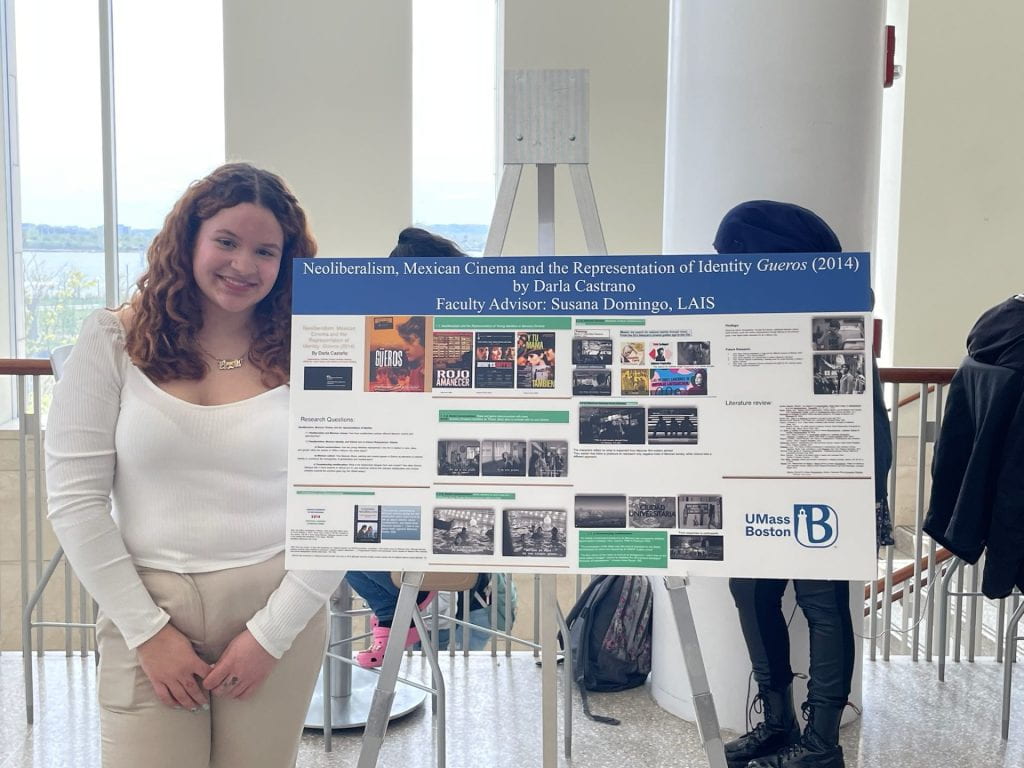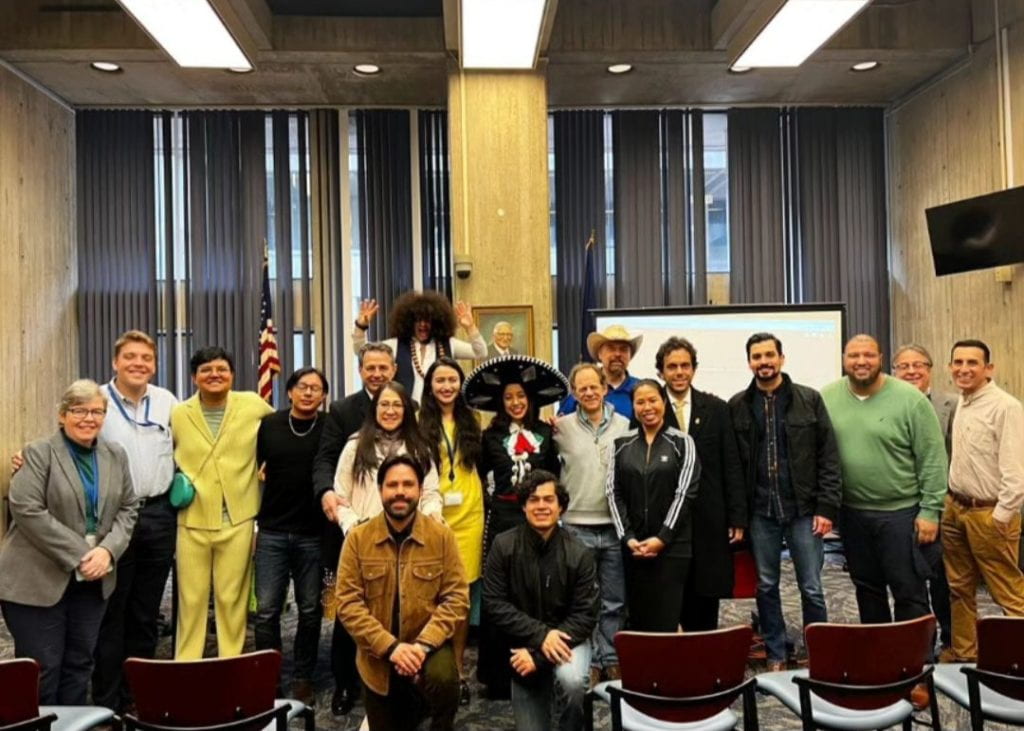





Professor Mark Schafer’s translation of the Spanish author Belén Gopegui’s novel Quédate este día y esta noche conmigo came out on March 21. Under the title Stay this Day and Night With Me, the novel invites us to think about timely topics such as AI, robots, free will, merit, and the beauty and pain of being human.
Here’s the blurb for the book from the publisher, City Lights Books:
This is the story of Olga, a retired mathematician, and Mateo, a college student passionate about robotics, and their plot to influence Google.
After a chance encounter at the public library, two new friends begin to meet up regularly. Together they decide to submit an application for Google sponsorship to an elite technology-training program. Hoping to stand out, they frame their submission as a direct appeal to the “conscience” of the seemingly all-powerful corporation.
Olga, a retired entrepreneur, and Mateo, a college student, find unexpected connection and solace in their conversations. Ideas and arguments open into personal stories as they debate the possibility of free will, the existence of merit, and the role of artificial intelligence. They ask the most basic and important of questions: What does it mean to be human in a reality shaped by data and surveillance? Is there still space for empathy and care? What could we be, what could we build, if we used our resources in different ways?
Link to the online book launch, a bilingual reading with the author and a conversation about the book, moderated by translator Katherine Silver:
Finally, a few great quotes about the translation:
“This book has excited me more than any that I have read this year.”–Sam Sacks, Wall Street Journal
“This is a beautifully written, endlessly provocative meditation on humanity’s relationship to technology, monopoly, memory and fate.”– Dave Eggers, author of The Circle and The Every
By Mark Schafer
May 5, 2023

City Hall, Boston, MA
Cinco de Mayo is a big holiday in the United States, celebrated with parades in New York, Denver, Chicago, Los Angeles, St Paul, Albuquerque, and elsewhere. But why in the world is a holiday commemorating the fleeting victory of the Mexican Army over the French on May 5, 1862, a minor holiday in Mexico but a major one in the U.S.? To answer this question, we need to go all the way back to September 16, 1810.
On that date, Father Miguel Hidalgo y Costilla, stood in his pulpit in the town of Dolores, in what is now the state of Guanajuato, and called for Mexico’s independence from Spain. He also called for racial equality, the redistribution of land, and the abolition of citizenship based on racial background. Hidalgo’s speech, the so-called “Grito de Dolores” (“Cry of Dolores”), effectively launched the Mexican War of Independence, which would last from 1810 to 1821. September 16 (not May 5!) is commemorated as Mexican Independence Day.
Fast forward almost two centuries. In the early 2000s, Dr. David Hayes-Bautista was poring over 19th-century Spanish-language newspapers in search of historical demographic data for Latinos. “I was investigating the level of health of Latinos during the Gold Rush and the Civil War,” Hayes-Bautista writes. “But there was no easy way to get that data: until 1880 there were no birth certificates, and until 1896 there were no death certificates.” So, he began reading Spanish language newspapers from the mid-19th century that served Latino communities in the U.S., since newspapers were responsible for announcements of social occasion, like births, deaths, weddings, quinceañeras, baptisms, and confirmations. One of the events that they were covering with particular attention, was the French intervention in Mexico.
In late 1861, 6,000 well-armed French troops stormed the port of Veracruz and set off for Mexico City to depose President Juárez. Juárez gathered a force of 2,000 poorly equipped men, many of them Zapotec and Mestizo Mexicans, and sent them to Puebla under the command of the Texas-born General Ignacio Zaragoza, where they met the French. The French Army was the most powerful in the world at that time, but the Mexican Army dealt a decisive defeat to the French, and the Battle of Puebla became a symbol of Mexican resistance to foreign domination.
But why is Cinco de Mayo a popular celebration in the United States? The answer has to do with the timing of the Mexican victory at Puebla. On May 5, 1862, the “United” States was in the grip of a civil war, and it did not look certain that the Union Army was going to win. It’s at this moment that the French land in Veracruz and head for Mexico City. In early May 1862, it looks likely that both the Confederacy and the French were going to win their respective wars.
On May 5, 1862, as Hayes-Bautista describes it, “the army of freedom and democracy finally beat the army of slavery and elitism, and it had an electrifying effect on Latinos all over the US West.” Latinos there used the first anniversary of the victory of the Battle of Puebla to raise money and recruit men to help Juárez’s forces in their fight against the French and to raise public opinion and morale in the U.S. They created, as Hayes-Bautista calls it, “a new public memory” a commemoration of the Battle of Puebla to support both Juárez AND Lincoln. Linking the U.S. Civil War and the Mexican war against the French, they began marching through the streets of the West and the Southwest, carrying both the Mexican and the U.S. flag.
By the early 20th century, the grandchildren of the original Cinco de Mayo Latinos, keepers of the memories of the first Cinco de Mayo commemorations, were vanishing—just as a million refugees from Mexico were arriving in the US in the West and Southwest, fleeing Mexico’s second brutal civil war, the Mexican Revolution (1910–1917.) The new arrivals notice that the Spanish-speaking communities celebrated this festival of “Cinco de Mayo”, and they continue the tradition. But because they don’t understand the history or significance of Cinco de Mayo for U.S. Latinos, the celebration becomes very Mexico-centered, filled with mariachi music, Adelita dances, tequila, etc.
In the 1940s, Cinco de Mayo is claimed by the burgeoning Mexican American civil rights movement and in the 1960s and 70s the Chicano Movement claims it as a celebration of Chicano Pride. But Cinco de Mayo doesn’t really begin to take off in the United States on a national level until the 1970s and ‘80s, when brewing companies began capitalizing on it as a way to appeal to consumers amid the rising popularity of Mexican restaurants.
Cinco de Mayo is celebrated in the U.S. because it started as a celebration of the hope and then the actual defeat of slavery, white supremacy, imperialism, and the forces that wanted to cruch democracy—in Mexico and the United States. Considering all of this, I’d like to make a modest proposal in terms of Cinco de Mayo symbolism and imagery: Out with the alcoholic drinks, the big sombreros, and the mariachi music! In with the symbols of the real Cinco de Mayo: the Constitution, a broken set of shackles, and a plate of mole poblano, the most famous delicacy of Puebla.
¡Qué viva la hermandad de México y los Estados Unidos! Long live the siblinghood of Mexico and the United States!
Source texts:
The Editors of Encyclopedia Britannica. “Cinco de Mayo | History, Celebrations, & Facts.” Encyclopædia Britannica, 8 Feb. 2019, www.britannica.com/topic/Cinco-de-Mayo. Accessed 3 May 2023.
History.com Editors. “Cinco de Mayo.” History, History, 29 Apr. 2019, www.history.com/topics/holidays/cinco-de-mayo. Accessed 1 May 2023.
Infante, Victoria. “Cinco De Mayo Is A 100-Percent American Celebration, Says David Hayes-Bautista, UCLA Professor (VIDEO)”. HuffPost, 4 May 2012, www.huffpost.com/entry/cinco-de-mayo-american-celebration_n_1478142. Accessed 1 May 2023.
Martinez-LeGrand, Nicole. “The Real History behind Cinco de Mayo.” Indiana Historical Society, 29 Apr. 2021, indianahistory.org/blog/the-real-history-behind-cinco-de-mayo/. Accessed 4 May 2023.
Munoz, Anabel. “The Origin of Cinco de Mayo Celebrations in the U.S. According to a UCLA Scholar.” ABC7 New York, 6 May 2021, abc7ny.com/cinco-de-mayo-puebla-where-did-start-what-is/10586437/. Accessed 1 May 2023.
Roos, Dave. “The Surprising Connection between Cinco de Mayo and the Civil War.” HISTORY, www.history.com/news/cinco-de-mayo-battle-puebla-civil-war. Accessed 1 May 2023
University of California Television (UCTV) “David Hayes Bautista the History of Cinco de Mayo.” Www.youtube.com, www.youtube.com/watch?v=MpYmjCUiRuw. Accessed 3 May 2023.
Walker, DeArbea. “Why Historians Believe Cinco de Mayo Prevented the Confederacy’s Win in the Civil War.” MSN, www.msn.com/en-us/news/world/why-historians-believe-cinco-de-mayo-prevented-the-confederacy-s-win-in-the-civil-war/ar-AAWXDTn. Accessed 1 May 2023.
Patrick Barron (Professor, English)
Gianni Celati: Selected Essays and Dialogues (University College London Press, forthcoming 2023) is a selection of Italian writer and filmmaker Gianni Celati’s critical work from the late 1960s to the near present translated into English & ranging in topic from environmental perception and archaeological conceptions of historical knowledge to street theater, slapstick comedy, photography, and translation.
Daniel C. Remein (Associate Professor, English)
The Heat of Beowulf (Manchester 2022) investigates twentieth-century poets Jack Spicer’s and Robin Blaser’s encounter with Beowulf as a comparative horizon by which to understand the multisensory, synesthetic, ecopoetical world of the Old English poem.
Isabel C. Gómez (Associate Professor, Latin American & Iberian Studies)
Cannibal Translation: Literary Reciprocity in Contemporary Latin America(Northwestern UP 2023) excavates a network of Latin American translation projects that resist assimilation by digesting, transforming, and challenging source materials.
